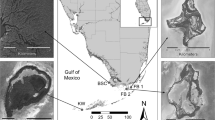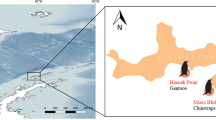Abstract
Bird communities reach their highest taxonomic and trophic diversity in tropical rain forest, but the use of different foraging strategies to meet food requirements in such competitive environments is poorly understood. Conventional dietary analyses are poorly suited to investigate dietary patterns in complex systems. We used stable carbon (13C/12C) and nitrogen (15N/14N) isotope analysis of whole blood to examine avian trophic patterns and sources of diet in the tropical rain forest of Los Tuxtlas, Veracruz, Mexico. We used stable nitrogen isotope analysis to delineate trophic levels, and stable carbon isotope analysis to distinguish the relative contribution of C-3 and CAM/C-4 ultimate sources of proteins to diets. There was large inter- and intraspecific variation in whole blood δ13C and δ15N values in 23 species of birds. Stable nitrogen isotope analysis separated birds into several trophic levels, including species that obtained their dietary protein mostly from plants, insects or a combination of both food sources. Stable carbon isotope analysis showed that most birds fed on C3-based foods but Stub-tailed Spadebills (Platyrinchus cancrominus) included C-3- and C-4/CAM-specialist individuals. Our analyses provided insights into the nutritional contribution of plant and animal sources of protein and distinguish their photosynthetic origin over relatively long average time periods.

Similar content being viewed by others
References
Ambrose SH, Norr L (1993) Carbon isotopic evidence for routing of dietary protein to bone collagen, and whole diet to bone apatite carbonate: purified diet growth experiments. In: Lambert J, Grupe G (eds) Molecular archeology of prehistoric human bone. Springer, Berlin Heidelberg New York, pp 1–37
Ben-David MA, Flynn RW, Schell DM (1997a) Annual and seasonal changes in diets of martens: evidence from stable isotope analysis. Oecologia 111:280–291
Ben-David MA, Hanley TA, Klein DR, Schell DM (1997b) Seasonal changes in diets of coastal and riverine mink; the role of spawning Pacific salmon. Can J Zool 75:803–811
Carabias J, Guevara S (1985) Fenología de una selva tropical húmeda y en una comunidad derivada: Los Tuxtlas, Veracruz. In: Gómez-Pompa A, del Amo S (eds) Investigaciones sobre la regeneración de selvas altas en Veracruz, México, vol II. Editorial Alhambra Mexicana, Mexico City, pp 27–66
Coates-Estrada R, Estrada A (1988) Frugivory and seed dispersal in Cymbopetalum baillonii (Annonaceae) at Los Tuxtlas, Mexico. J Trop Ecol 4:157–172
Coates-Estrada R, Estrada A (1989) Avian attendance and foraging at army-ant swarms in the tropical rain forest of los Tuxtlas, Veracruz, México. J Trop Ecol 5:281–292
Estrada A, Coates-Estrada R (2001) Species composition and reproductive phenology of bats in a tropical landscape at Los Tuxtlas, Mexico. J Trop Ecol 17:627–646
Fleming TH (1995) The use of stable isotopes to study the diets the plant-visiting bats. In: Racey PA, Swift SM (eds) Ecology, evolution and behaviour of bats. Clarendon Press, Oxford, pp 99–110
Greene E, Wilcove D, McFarland M (1984) Observations of birds at an army ant swarm in Guerrero, Mexico. Condor 86:92–93
Herrera LG, Fleming TH, Sternberg LS (1998) Trophic relationships in a neotropical bat community: a preliminary study using carbon and nitrogen isotopic signatures. Trop Ecol 39:23–29
Herrera LG, Hobson KA, Estrada D, Manzo A, Méndez G, Sánchez-Cordero V (2001). The role of fruits and insects in the nutrition of frugivorous bats: evaluating the use of stable isotope models. Biotropica 33:520–528
Herrera LG, Gutierrez G, Hobson K, Altube B, Díaz W, Sánchez-Cordero V (2002) Sources of assimilated protein in five species of New World frugivorous bats. Oecologia 133:280–287
Hobson KA, Clark RW (1992a) Assessing avian diets using stable isotopes. I. Turnover of 13C in tissues. Condor 94:179–186
Hobson KA, Clark RW (1992b) Assessing avian diets using stable isotopes. II. Factors influencing diet-tissue fractionation. Condor 94:189–197
Hobson K A, Clark RW (1993) Turnover of 13C in cellular and plasma fractions of blood: implications for nondestructive sampling in avian dietary studies. Auk 110:638–641
Hobson KA, Stirling I (1997) Low variation in blood δ13C among Hudson Bay polar bears: implications for metabolism and tracing terrestrial foraging. Mar Mamm Sci 13:359–367
Hobson KA, Alisauskas RT, Clark, RG (1993) Stable-nitrogen isotope enrichment in avian tissues due to fasting and nutritional stress: implications for isotopic analyses of diet. Condor 95:388–394.
Hobson KA, McLellan BN, Woods J (2000) Using stable-carbon (δ13C) and nitrogen (δ15N) isotopes to infer trophic relationships among black and grizzly bears I Upper Columbia River Basin, British Columbia. Can J Zool 78:1332–1339
Höfling E, Lencioni F (1992) Avifauna da floresta Atllântica, Regiao de Salesópolis, Estado de Sao Paolo. Rev Brasil Biol 52:361–378
Howe HF (1982) Fruit production and animal activity in two tropical trees. In: Leigh EF Jr, Rand AS, Windsor DM (eds) The ecology of a tropical forest: seasonal rhythms and long-term changes. Smithsonian Institution Press, Washington, DC, pp 189–199
Kelly JF (2000) Stable isotopes of carbon and nitrogen in the study of avian and mammalian trophic ecology. Can J Zool 78:1–27
Lajtha K, Marshall JD (1994) Sources of variation in the stable isotopic composition of plants. In: Lajtha K, Michener RH (eds) Stable isotopes in ecology and environmental sciences. Blackwell, Oxford, pp 1–21
Lajtha K, Michener RH (1994) Stable isotopes in ecology and environmental science. Blackwell, Oxford
Loiselle BA, Blake JG (1999) Dispersal of melastome seeds by fruit-eating birds of tropical forest understory. Ecology 80:330–336
McDiarmid RW, Ricklefs RE, Foster MS (1977) Dispersal of Stemmadenia donell-smithii (Apocynaceae) by birds. Biotropica 9:9–25
Morton ES (1973) On the evolutionary advantage and disadvantages of fruit eating in tropical birds. Am Nat 107:8-22
Nadelhoffer KJ, Fry B (1994) Nitrogen isotopes studies in forest ecosystems. In: Lajtha K, Michener RH (eds) Stable isotopes in ecology and environmental science. Blackwell, Oxford, pp 22–44
Parrish JD (1997) Patterns of frugivory and energetic condition in Neartic landbirds during autumn migration. Condor 99:681–697
Phillips DL (2001) Mixing models in analyses of diet using mutiple stable isotopes: a critique. Oecologia 127:166–170
Powell GV (1979) Structure and dynamics of interespecific flocks in neotropical mid-elevation forest. Auk 96:375–390
Prance GT (1982) Biological diversification in the tropics. Columbia University Press, New York, pp 714
Ray T (1983) Syngonium triphyllum (Mano de Tigre). In: Janzen DH (ed) Costa Rican natural history. University of Chicago Press, Chicago, pp 333–335
Remsen Jr JV, Hyde MA, Chapman A (1993) The diet of neotropical trogons, motmots, barbets and toucans. Condor 95.178–192
Rosenberg KV, Cooper RJ (1990) Approaches to avian diet analysis. Stud Avian Biol 13:80–90
Sargent S (2000) Specialized seed dispersal: mistletoes and fruit-eating birds. In: Nadkarni NM, Wheelwright N (eds) Monteverde: ecology and conservation of a tropical cloud forest. Oxford University Press, New York, pp 288–289
Schoener TW (1986) Resource partitioning. In: Kikkawa J, Anderson DJ (eds) Community ecology: pattern and process. Blackwell, Oxford, pp:91–126
Sherry TW (1984) Comparative dietary ecology of sympatric insectivorous neotropical flycatchers (Tyrannidae). Ecol Monogr 54:313–338
Skutch AF (1980) Arils as food for tropical American birds. Condor 82:31–42
Slud P (1964) The birds of Costa Rica: distribution and ecology. Bull Am Mus Nat Hist 128:1-430
Smith BN, Epstein S (1971) Two categories of 13C/12C ratios for higher plants. Plant Physiol 47:380–384
Snow DW (1981) Tropical frugivorous birds and their food plants: a world survey. Biotropica 13:1-14
Stouffer PC, Bierregaard Jr RO (1997) Spatial and temporal abundance patterns of Ruddy quail-doves (Geotrygon montana) near Manaus, Brazil. Condor 95:896–903
Terborgh J, Robinson S (1986) Guilds and their utility in ecology. In: Kikkawa J, Anderson DJ (eds) Community ecology: pattern and process. Blackwell, Melbourne, pp 65–90
Valburg LK (1992a) Feeding preferences of common bush-tanagers for insect-infested fruits: avoidance or attraction? Oikos 65:29–33
Valburg LK (1992b) Flocking and frugivory: the effect of social grouping on resource use in the common bush-tanager. Condor 94:358–363
Wheelwright NT, Haber WA, Murray KG, Guindon C (1984) Tropical fruit-eating birds and their food plants: a survey of a Costa Rica lower montane forest. Biotropica 16:173–192
Willis EO (1980) Ecological roles in migratory and resident birds on Barro Colorado island, Panama. In: Keast A, Morton ES (eds) Neotropics; ecology, behavior, distribution and conservation. Smithsonian Institution Press, Washington, D.C., pp 205–225
Withers PC (1992) Comparative animal physiology. Saunders College, Fort Worth, Tex.
Worthington A (1989) Adaptations for avian frugivory: assimilation efficiency and gut transit time of Manacus vitellinus and Pipra mentalis. Oecologia 80:381–389
Acknowledgements
This work was supported by a grant from the Consejo Nacional de Ciencia y Tecnología to L.G.H.M. (31849-N), and an operating grant to K.A.H. from the Canadian Wildlife Service of Environment Canada. Stable isotope analyses were conducted at the Department of Soil Science, University of Saskatchewan. P. Healy assisted with the preparation of stable isotope samples and D. Curiel helped during the field work.
Author information
Authors and Affiliations
Corresponding author
Rights and permissions
About this article
Cite this article
Herrera, L.G., Hobson, K.A., Rodríguez, M. et al. Trophic partitioning in tropical rain forest birds: insights from stable isotope analysis. Oecologia 136, 439–444 (2003). https://doi.org/10.1007/s00442-003-1293-5
Received:
Accepted:
Published:
Issue Date:
DOI: https://doi.org/10.1007/s00442-003-1293-5




